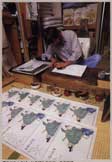Shokunin vs Craftsman
During the seven years that I have been living here in Japan and studying woodblock printmaking, I have visited many shokunin and have enjoyed long discusions with them about their life and work. I have been surprised by many of the things they have said, and have come to realize that their thinking is sometimes quite different from my Western conceptions of a craftsman.

Let me tell you about a Westerner's idea of a 'craftsman'. The following images immediately come to mind: an experienced, skilled worker ... someone methodical, who slowly and carefully crafts his products ... patient ... willing to take as much time as necessary to produce quality work ... carefully, carefully! I can imagine English readers of this newsletter nodding their heads in general agreement. But when we stop our Japanese 'man on the street' and ask him about his concept of a 'shokunin', what do we get? 'An experienced, skilled worker ... someone with a deep knowledge of his tools ... able to work with incredible speed ... to turn out quality work ...' Now it is my Japanese readers who are nodding. If I as a Westerner hear a story about say, a guitar maker in Spain who takes a year to carefully build each instrument, I am lost in admiration. To a Japanese shokunin, this is inconceivable, and to him it is a horrible insult to be thought of as a slow worker.
As someone who was raised in Western thinking, and who is now trying to work as a craftsman in Japan, the situation for me is thus somewhat schizophrenic. The question is not really one of simply speed, but rather one of 'intellectual involvement'. We Westerners obviously like to work with our 'brain', analyzing, calculating, and controlling every step of the process. The Japanese perhaps like to bypass this organ, and allow the body and muscles (well-trained) to do the work more 'naturally'. The same thing is apparent in the way we learn things. I want to inspect, study and analyze the process. I want to 'figure it out'. The Japanese seem to learn by osmosis, by rubbing shoulders with a skilled practitioner. I am reminded of the Japanese shakuhachi teacher who stopped accepting any more Western students. "They ask too many questions," he cried!
I have learned most of what I know about printmaking by working alone and trying to 'figure it out'. Of course I have had occasional help from people in the field, but my approach has been by and large 'analytical'. I am now beginning to realize that I will probably not be able to improve much further this way. My carving is now 'correct', the lines all in the right places, the right thickness. My printing is just as 'correct', smooth colours, neatly fitted within those lines. This is not enough. Perhaps my collectors are happy with what they see, but I can see more. Or perhaps it is more correct to say I don't see .. and what I don't see is 'life' ... motion. My carved lines don't dance across the page.
The solution is obvious. Time. Time spent with experienced craftsmen shokunin. Listening to the sounds of their work. Breathing the same air as they, and drinking the same o-sake. Simply sitting in the same room. And not asking questions! And if I can do more of this, then perhaps one day sometime in the future, I too can stop analyzing, and start dancing!
TV Listings
The 'Woodblock Shimbun' has a full selection of TV programs on file. Videos available include some of David's news appearances, complete feature programs, and some short documentaries on his work. The files are in QuickTime format, and can be easily viewed with your browser.
Program listings are on the Index page ... ![]()
Enchanting Japan
Colourful woodblock prints - for people all over the world, to hear this phrase is to think of Japan. Japan has a long history of woodblock printing, or hanga, originally for illustrations for books. By the late seventeenth century, hanga in the ukiyo-e style came into its own as an art form, and prints came to be appreciated on their own merits. The many woodblock prints that accurately depict life in the Edo period are excellent examples of this tradition. Whether a print of a geisha, a kabuki actor strutting on stage, or even a completely modern image, the woodblock printing technique seems to provide the perfect means of expression to capture the essence of things Japanese. (1998)
Full Story. ![]()
Carving a Career From an Ancient Japanese Craft
David Bull, a 41-year-old Canadian university
dropout born in England who used to program computers and play the
flute on the street, anticipates one day finding himself revered as a
master practicioner of an ancient Japanese craft. But it took him 35
years to hit upon that uncommon ambition. (1993)
Full Story. ![]()
Japanese Art with a Canadian Touch
A British-born artist from Canada is holding an exhibition of his 60 works of ukiyoe woodblock prints, part of his 10-year project to carve and print the Hyakunin Isshu poem collection. (1998)
Full Story. ![]()




